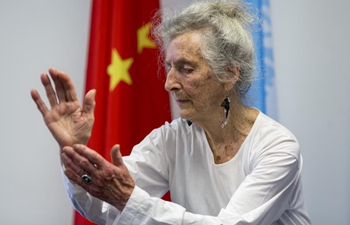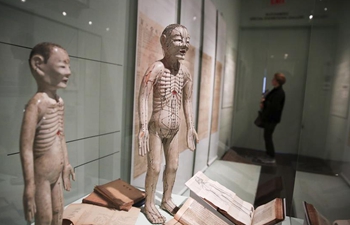WASHINGTON, April 26 (Xinhua) -- In three studies published on Thursday in the journal Science, Harvard Medical School and Harvard University researchers reported how they systematically profiled every cell in developing zebrafish and western claw-toed frog embryos to establish a roadmap revealing how one cell builds an entire organism.
Using single-cell sequencing technology, the researchers traced the trajectories of individual cells over the first 24 hours of the life of an embryo, revealing a landscape of which genes are switched on or off, and when embryonic cells transition into new cell states and types.
The findings represented a catalog of genetic "recipes" for generating different cell types in two important model species and provided an unprecedented resource for the study of developmental biology and disease.
"We foresee that any complex biological process in which cells change gene expression over time can be reconstructed using this approach," said Alexander Schier, professor of molecular and cellular biology at Harvard and a corresponding author of one of the studies. "Not just the development of embryos but also the development of cancer or brain degeneration."
The researchers captured gene expression data from each cell of the embryo, one cell at a time. The teams collectively profiled more than 200,000 cells at multiple time points over 24 hours for both species.
To map the lineage of essentially every cell as an embryo develops, along with the precise sequence of gene expression events that mark new cell states and types, the teams developed new experimental and computational techniques, including the introduction of artificial DNA bar codes to track the lineage relationships between cells.
"Understanding how an organism is made requires knowing which genes are turned on or off as cells make fate decisions, not just the static sequence of a genome," said Sean Megason, associate professor of systems biology in Harvard Medical School.
"This is the first technological approach that has allowed us to systematically and quantitatively address this question," said Megason.
Also, the researchers developed a cellular "family tree" that revealed how gene expression in 25 cell types changed as they specialize, and they managed to reconstruct the spatial origins of the various cells types in the early zebrafish embryo.
RECIPE FOR CELL MAKING
The analyses were unprecedented in revealing in comprehensive detail the cascades of events that take cells from early progenitor or "generalist" states to more specialized states with narrowly defined functions.
The teams identified otherwise difficult-to-detect details such as rare cell types and subtypes and linked new and highly specific gene expression patterns to different cell lineages. In several cases, they found cell types emerging far earlier than previously thought.
For scientists hoping to manipulate stem cells toward specific fates with the goal of replacing defective cells, tissues or organs with functional ones, the newly details about the sequence of gene expression changes that precipitate the emergence of specific cell types can propel these efforts further.
"With these datasets, if someone wants to make a specific cell type, they now have the recipe for the steps that those cells took as they formed in the embryo," said Allon Klein, assistant professor of systems biology and co-corresponding author of two of the three studies.
"We've in some sense established a gold standard reference for how complex differentiation processes actually progress in embryos, and set an example for how to systematically reconstruct these types of processes," Klein said.
NEW FINDINGS
Klein's team used the CRISPR/Cas9 gene editing system to create zebrafish with a mutant form of chordin, a gene involved in determining the back-to-front orientation of a developing embryo.
Schier's team took a similar approach by profiling zebrafish with a mutation in a different patterning gene known as one-eyed pinhead.
When analyzed with single-cell sequencing, the teams independently found that at the single-cell level, gene expression was the same in mutants and wildtype, despite the loss of an essential signaling pathway. The proportions of different cell types, however, changed.
Also, when the researchers compared cell-state landscapes between zebrafish and frog embryos, they observed mostly similarities.
In several instances, they found that the DNA sequence of a gene and the structure of the protein it encodes could be nearly identical between species but have very different expression patterns.
"This really shocked us, because it goes against all the intuition we had about development and biology," Klein said. "It directly challenges our idea of what it means to be a certain cell type."
In another finding, the teams observed that the process of cell differentiation into distinct cell types, which is commonly thought to occur in a tree-like structure where different cell types branch off from a common ancestor cell, can form "loops," not only branches.
The neural crest, a group of cells that give rise to diverse tissue types including smooth muscle, certain neurons and craniofacial bone, initially emerged from neural and skin precursors, but could generate cells that appear almost identical to bone and cartilage precursors.
All three teams also identified certain cell populations that existed in a kind of intermediate "decision making" state.
At certain key developmental branch points, cells appeared to go down one developmental trajectory but then changed their fate to another trajectory.
"With multilineage cells, we have to start wondering if their final fate is being determined by some selective force or interaction with the environment, rather than just genetic programs," said Marc Kirschner, professor of systems biology at Harvard Medical School, a paper's co-author.
The newly generated data sets and the new tools and technologies developed as part of these studies have laid the foundation for a wide spectrum of future exploration, according to the authors.
The next leap, the teams suggested, would be to better understand how cell-fate decisions are made.
"What we need to do is to figure out the signals that direct cells down certain roads, and what the internal mechanisms are that allow cells to make those decisions," said Megason.













